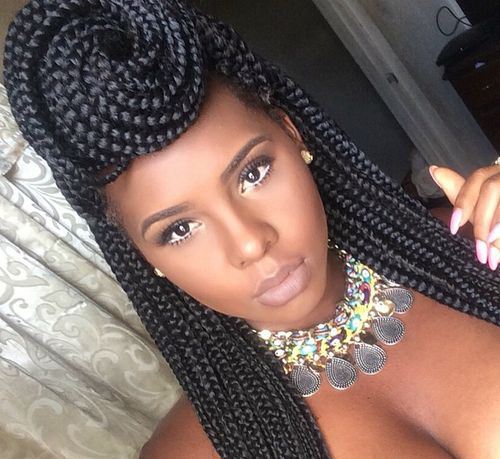Braided hairstyles in Kenya reflect a blend of creativity, culture, and modern beauty trends.
From classic cornrows to bold knotless braids, Kenyans have embraced braiding as both an art form and a practical way to style hair.
Whether you’re looking for something simple and elegant or intricate and statement-making, there’s a braid style to suit every taste.
Here’s a look at some of the most popular braided hairstyles in Kenya today.
Table of Contents
Braided Hairstyles in Kenya #1. Box Braids

Box braids are a staple in Kenyan hairstyling.
These braids are divided into square-shaped sections and can vary in size and length. They’re versatile, allowing for various styling options and are often adorned with beads or colored threads for added flair.
2. Cornrows
Cornrows involve braiding the hair close to the scalp in straight or curved lines.
This style is celebrated for its neat appearance and low maintenance, making it ideal for various occasions.
In Kenya, cornrows are commonly worn by both men and women, often styled in intricate patterns or adorned with accessories like beads.
3. Knotless Braids
Knotless braids are a modern take on traditional box braids, where hair extensions are added without knots at the base.
This technique reduces tension on the scalp and provides a more natural look. In Kenya, this style has gained popularity for its comfort and sleek finish.
4. Lemonade Braids
Inspired by Beyoncé‘s iconic look, lemonade braids involve a side part with one side braided and the other left loose.
This asymmetrical style is both edgy and chic, making it a popular choice for fashion-forward individuals in Kenya.
5. Goddess Braids
Goddess braids are thick, raised cornrows that often form intricate patterns.
They exude elegance and are suitable for both casual and formal settings. In Kenya, goddess braids are often styled with added curls or accessories to enhance their appeal.
6. Feed-In Braids
Feed-in braids are a technique where hair extensions are gradually added to natural hair, creating a seamless and natural-looking braid.
This style is less bulky and more comfortable, making it a preferred choice for many in Kenya.
7. Passion Twists
Passion twists are two-strand twists made with curly hair extensions, resulting in a voluminous and textured look.
They’re lightweight and ideal for a bohemian vibe, and have become a trendy choice among Kenyan youth.
8. Bob Braids
Bob braids are shorter braids that typically end at the chin or shoulder. This style is trendy and easy to maintain, offering a youthful appearance. In Kenya, bob braids are often styled with curls or waves for added texture.
I recently changed my Facebook profile picture and got many comments from friends telling me how gorgeous I look.
I received their compliments graciously, but to tell you the truth, I half-expected them.

It’s not that I am vain or full of myself (at least I don’t think so); rather, I am just fully aware of how flattering plaited hairstyles are on me.
READ ALSO: 2000s Hair Trends: 4 Trendy Styles for You to Replicate Today
In fact, that’s why I chose to style my hair that way.
I was going away on vacation with a special someone and wanted to make sure that I looked beautiful—all the time—with minimal fuss.
READ ALSO: Elevate Your 2023 Style with a Clip Hair Style: Embracing Versatility and Easy Glamour
See for yourself!
READ ALSO: Colour 30 Braids on Dark Skin & Other Awesome Braid Colours
Photo credits: Supa Deals Kenya